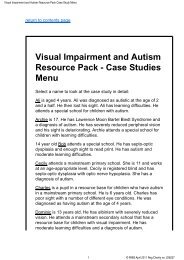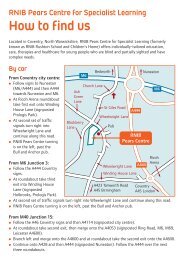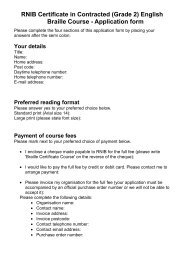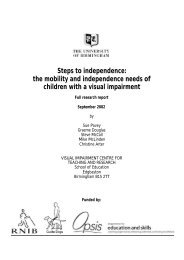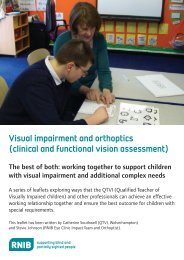Vocational rehabilitation: The business case for retaining ... - RNIB
Vocational rehabilitation: The business case for retaining ... - RNIB
Vocational rehabilitation: The business case for retaining ... - RNIB
You also want an ePaper? Increase the reach of your titles
YUMPU automatically turns print PDFs into web optimized ePapers that Google loves.
Case study 2<br />
This <strong>case</strong> study is based upon a 48-year-old employee with a hearing impairment<br />
who required a cochlea implant to sustain her in employment with the Institution of<br />
Occupational Safety and Health.<br />
Costs<br />
Salary of the fulltime employee £24,000<br />
Annual hours worked 1,820<br />
Salary per hour £15.56<br />
Cost of sickness<br />
Higher average sickness absence (see Note 1) £1,019<br />
Cost of providing reasonable adjustments<br />
Occupational health <strong>case</strong> management £150<br />
Equipment £1,000<br />
Management time £500<br />
Support functions time (HR, IT etc) £1,000<br />
Total cost £2,650<br />
Costs of replacement<br />
Recruitment administration £246<br />
Business disruption (see Note 2) £3,268<br />
Induction and training £750<br />
Sub total £4,264<br />
Costs of termination<br />
Termination costs (see Note 3) £6,535<br />
Total cost of replacement £10,799<br />
Retention benefit £8,148<br />
Notes<br />
Note 1: This is based on an average sickness absence rate of 7.2 per cent <strong>for</strong> disabled<br />
employees compared to 3 per cent (131 x hourly rate divided by 2 as full pay not paid<br />
<strong>for</strong> all sick leave)<br />
Note 2: Business disruption is calculated as six weeks salary, ie the time it might take to<br />
typically replace the employee<br />
Note 3: Termination costs are estimated at 12 weeks notice.<br />
17









